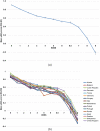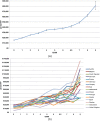New insights into the burden and costs of multiple sclerosis in Europe
- PMID: 28273775
- PMCID: PMC5476197
- DOI: 10.1177/1352458517694432
New insights into the burden and costs of multiple sclerosis in Europe
Abstract
Background: The current focus in multiple sclerosis (MS) is on early diagnosis and drug intervention, with a view to modifying disease progression. Consequently, healthcare costs have shifted from inpatient care and rehabilitation to outpatient care.
Objectives: This European burden of illness study provides data that can be combined with other evidence to assess whether management approaches provide value to society.
Methods: A cross-sectional study was conducted in 16 countries. Patients reported on their disease, health-related quality of life (HRQoL) and resource consumption. Descriptive analyses were performed by disease severity. Costs are reported from a societal perspective in 2015€ PPP (adjusted for purchasing power parity).
Results: The 16,808 participants had a mean age of 51.5 years, and 52% had relapsing-remitting multiple sclerosis (RRMS). Work capacity declined from 82% to 8%, and utility declined from normal population values to less than zero with advancing disease. Mean costs were 22,800€ PPP in mild, 37,100€ PPP in moderate and 57,500€ PPP in severe disease; healthcare accounted for 68%, 47% and 26%, respectively. Fatigue and cognitive difficulties were reported by 95% and 71% of participants, respectively; both had a significant independent effect on utility.
Conclusion: Costs and utility were highly correlated with disease severity, but resource consumption was heavily influenced by healthcare systems organisation and availability of services.
Keywords: HRQoL; Multiple sclerosis; burden of illness; cognition; costs; fatigue.
Conflict of interest statement
Figures







Comment in
-
Can we afford not to prevent MS-related disability?Mult Scler. 2017 Jul;23(8):1048-1049. doi: 10.1177/1352458517703804. Epub 2017 May 15. Mult Scler. 2017. PMID: 28504007 No abstract available.
References
-
- Jönsson B. Cost-effectiveness of Helicobacter pylori eradication therapy in duodenal ulcer disease. Scand J Gastroenterol Suppl 1996; 215: 90–95. - PubMed
-
- O’Brien B. Multiple sclerosis. London: Office of Health Economics, 1987, https://www.ohe.org/system/files/private/publications/162%20-%201987_Mul... (accessed 5 October 2016).
-
- Blumhardt L, Wood C. The economics of multiple sclerosis: A cost of illness study. Br J Med Econ 1996; 10: 99–118.
-
- Henriksson F, Jönsson B. The economic cost of multiple sclerosis in Sweden in 1994. Pharmacoeconomics 1998; 13: 597–606. - PubMed
MeSH terms
LinkOut - more resources
Full Text Sources
Other Literature Sources
Medical

